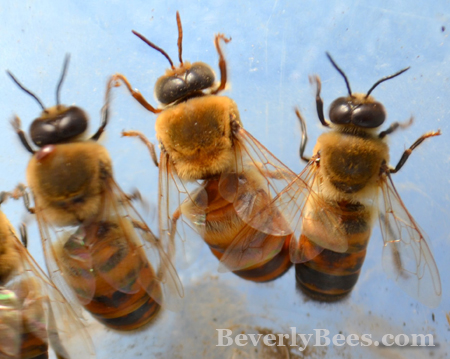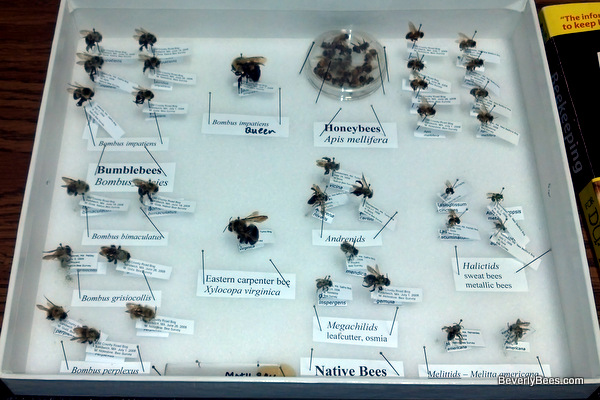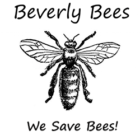Massachusetts Beekeepers spring meeting included talks on Queen Rearing and How Neonicotinoids Harm Native Bees
A few weeks ago, I attended the Massachusetts Beekeepers Association spring meeting, hosted by Essex County Beekeepers Association. The highlights for me at these meetings are chatting with other beekeepers, learning tricks of the trade or different methods of doing things, and getting briefed on the current research in the field. Joe Kovaleski, Anne Averill, PhD, and Bill Mares were the key speakers there.
Techniques in Queen Rearing
First up was Joe Kovaleski who gave an excellent talk on Queen Rearing. He is a Master Beekeeper, an expert in Queen Rearing techniques, and is involved in both the Ohio State and West Virginia Queen Rearing Programs. Joe is a wealth of knowledge. He talked about the importance of locally raised queens who are proven survivors in your area. These queens have advantages over queens raised elsewhere who may not produce the bees that thrive best in your local climate.
He explained the different types of queen cells (swarm, supercedure and emergency cells) and ways to make new queens via cell punching, grafting, the miller method, cell builder hives and more. He also gave this important tip – when only choosing one queen cell to keep for your new queen, always pick the longest cell. It is an indication that particular larvae was fed more royal jelly than the others and will usually produce the best queen.
He then talked about the importance of drones. He mentioned mature drones must be present in large numbers in order to raise good queens. It takes drones 40 days to reach sexual maturity. It takes 24 days from the time the egg is laid to emergence and 12 -16 more to reach sexual maturity. This is much longer than the 23 days the queen takes to develop. It only takes her 16 days from egg to emergence and 3-7 more days before she leaves for her mating flight. Although queens can be developed any time of year to get a multiple mating with good genetic diversity you first need lots of mature drones.

Joe then talked about the environment that needs to be created in order for the bees to make queens. The conditions you want for queen rearing include a crowded brood nest, an overabundance of nurse bees who make the royal jelly, stimulation of comb builders by feeding syrup, an abundance of pollen used by the nurse bees for making the royal jelly, good ventilation, lack of queen pheromones from a queen-less hive and the presence of young larvae.
He also explained how to make a basic cell builder hive for queen rearing. Cell builder hives are made in a deep super and require an abundance of food (syrup plus 2 frames of honey and pollen), an abundance of capped brood (5 frames without eggs) and an abundance of bees, in fact 5-6 pounds worth. A frame of foundation is inserted in the middle as a place holder until the grafted cell bars are ready.
After you have successfully raised queen cells, you need to make a mating Nuc for each new queen. The virgin queen needs to mate, establish a good laying pattern and produce brood, before she can be considered “tested” and used as a new queen for another hive. Later in the day he gave a more technical talk on the details of Queen Rearing by Grafting.
Neonicotinoids Harm Native Bees
The second speaker was Anne Averill, PhD. She is an Associate Professor of Entomology at the University of Massachusetts and specializes in Cranberry Insects and Integrated Pest Management. She was fascinating to listen to as she explained the different types of native bees in the cranberry bogs in the area and her research on them. She talked about some of the different families of native bees including the Andrenidae (Mining Bees), Halictidae (Sweat Bees), Megachilidae (Mason and Leaf Cutter Bees) and Apidae (bumble bees and honey bees – Apis Mellifera among others).

She talked about research done in 2003 by Cane and Schiffhauer which showed cranberry fruit weight was higher when pollinated by bumble bees followed by several other native bee species and then the honeybee. She also talked about research which showed the more diverse the bee species are that visit a pumpkin flower, the larger the pumpkins will be that grow from that flower. This indicates the importance of native pollinators and shows that diversity of bees is significant to fruit production and the environment. Smaller bees like many native bees do not forage as far as honey bees and so it is important they live close to their food source.
She went on to say how some native bee species have virtually disappeared from the cranberry bogs over the last few years. There are new pesticides which may be to blame. They are highly toxic to bees, have residual effects and are systemic. They may be even more toxic to smaller bodied native bees. Some of these pesticides are already banned in Europe. These pesticides are called Neonicotinoids and act as nerve poison to bees. They are widely used in America by landscape companies and homeowners and have residual soil effects lasting 2-3 years after application. After only a small dose of this pesticide to the soil it may be taken in by a flower or other plant and move into the plants nectar and pollen. In fact these neonicotinoid pesticides have even been found in extremely low levels in pollen collected from bumblebees.
She then put up a chart showing which chemical compounds are highly toxic to bees. I will list them in order with the most toxic first and the least toxic last.
Toxic Chemicals To Bees
- Admire (imidacloprid) -Most Toxic
- Actara (thiamethoxam) -Very Toxic
- Delegate/SpinTor/Entrust -Very Toxic
- Avaunt (indoxacarb) – Very Toxic
- Lorsban (chlorpyrifos) – Toxic
- Diazinon – Toxic
- Assail (acetimiprid) – Toxic
- Intrepid, Confirm – Less Toxic
She went on to state – Some Neonicotinoids are very toxic to bees on acute contact. These include – Sevin, Guthion with Admire Neonicotinoid being the most toxic. Sometimes these pesticides are given other names which may include Gaucho, Confidor and Winner. Fatal effects occur when bees come in contact with a dose one billionth the size of a small paperclip.
These insecticides are so dangerous because they kill native pollinators by an acute or lethal dose but also by sublethal doses which affect the normal functioning and physiology of the bees. For instance Admire (imidacloprid), a neurotoxin, effects the homing behavior of bumblebees. When they can’t find their way home they will die. She talked about her research which showed that the smaller the bumble bee was the greater the affect Admire (imidacloprid) had on its homing instinct. Smaller bumble bees had a harder time finding their way home than larger bees when they were treated with this pesticide and displaced from the nest. This indicates that Admire (imidacloprid) has a significant effect on homing behavior when given as a sublethal dose.
Anne finished up by talking about how Bees use landmarks to find their way home. In diverse settings it is easier for bees to navigate. When a farmer grows a monoculture crop it is harder for the bees to navigate, since everything looks the same. She suggested that bees in monoculture settings may have a harder time then bees in more diverse settings when also effected by sublethal doses of the neurotoxic insecticides.
Norman Shaw a 97-year-old beekeeper from Norfolk County Beekeepers Association was then awarded the Massachusetts beekeeper of the year award. His slogan is “I never met a beekeeper I didn’t like.” I couldn’t agree with him more.
After lunch and the raffling of beekeeping goods and bees, Bill Mares, a lifelong beekeeper and EAS president gave an entertaining talk on his Bee Adventure in Central America, complete with photos. It is amazing how different things are down there in the beekeeping world. The presentation was both fun and enlightening.
If you have a local bee club I highly recommend getting involved and taking part in all the beekeeping hoopla. It’s fun getting together with fellow beekeepers and geeking out on bees. At this meeting I coincidentally sat next to someone who is a fan of my blog and who recognized me from my pictures here. I enjoyed talking to him and learning about his hives. It is always great to find out more about my readers! Do you have any beekeeping stories to share? Let me know in the comments below.
Other Posts You May Enjoy:
- Mass Bee Field Day – A Carnival For Beekeepers
- Blue Pollen, Honeybees and Siberian Squill
- In Case You’re Wondering Bees Can Chew Through Garden Row Cover
